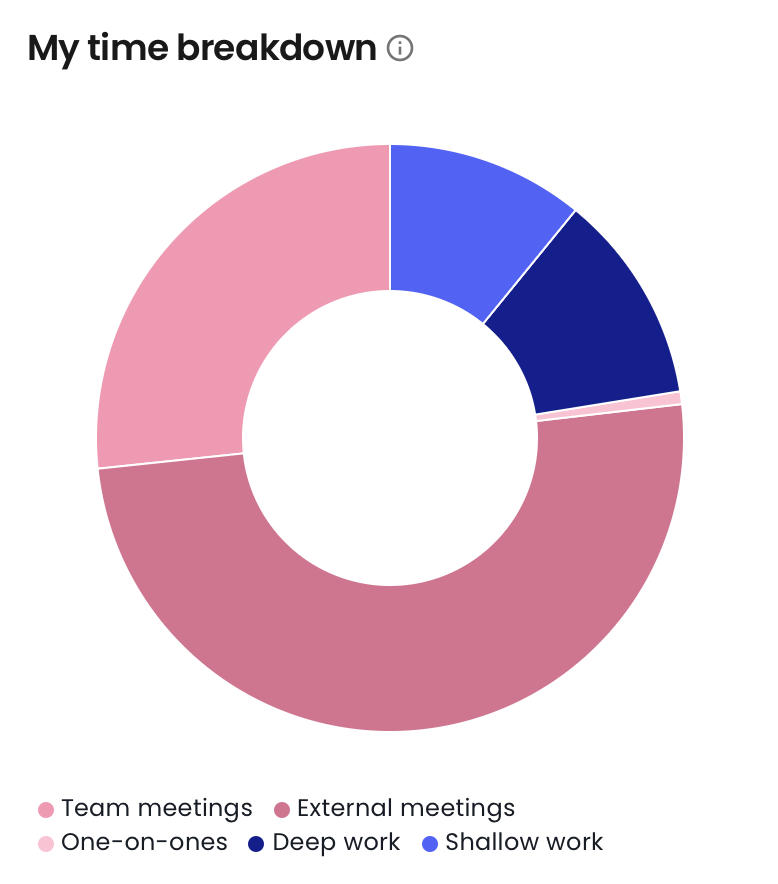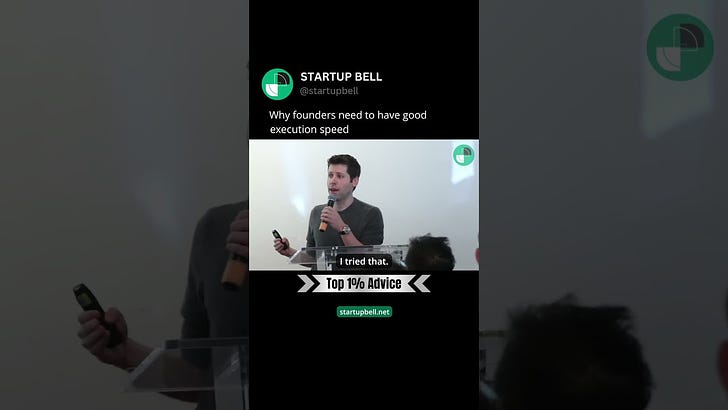What did you do last week?
Meetings will kill your company, not AI
Quick question:
Did you check your email during your last Zoom meeting? Or text, or flick through Instagram or any other of the myriad distractions available to us?
And if you were paying attention instead, how many other people on the call were distracted (and presumably doing email)?
This begs the question: if you are able to do email in an online meeting, why are you in that meeting in the first place? Is that the best use of your time?
This single observation raises a host of questions, everything from social decorum and norms (would you be reading email if you were in an in-person meeting?) to the debate between remote working and working in an office. (As a side note, Jamie Dimon, the CEO of JP Morgan, recently was recorded talking about his views on this—if you haven’t heard, it’s worth a listen)
In my mind, however, the real question is not online meetings or a return to office. The real question is, “How many meetings and how productive are those meetings”?
I have been using reclaim.ai from Dropbox recently as a calendaring tool. The reports it has are fascinating—here is an analysis of the last four weeks of work time for me:
This data was fascinating. For better or worse, the bulk of my work days are spent on online calls with the various companies that I work with. Then, in the evenings, I find some uninterrupted “maker time” to code or otherwise do meatier work on my own. But after accounting for email time and the like (“shallow work”), roughly only 10% of my time currently is spent doing deeply technical work individually.
Anecdotally, many of the executives and companies I work with are caught in a similar dilemma. A fellow CEO recently lamented that most of her team’s time was spent in meetings.
Meetings about what? What got accomplished? Did those meetings need everyone to be there?
Enter AI
At this point, I expect most of my readers have experienced at least some productivity wins from using AI tools like ChatGPT, Cursor, and similar. In my own work, I use these tools for everything from automatically doing all of my accounting (thanks Puzzle.io!) to doing deep research on various companies and technical topics to writing code, of course! The wins and productivity gains are truly staggering (not to mention fun to be on the bleeding edge!)
However, most of those productivity gains come from the 10% of the time that I spend doing “deep work.”
Ouch!
For any business that is based in some way or other on knowledge work, these kinds of metrics should be incredibly painful and a wake-up call. Imagine running a factory where the factory line only ran 10% of the time. Or running a restaurant, but you could only use 10% of the stoves and ovens in the kitchen.
To be fair, time spent in many meetings can be very valuable—particularly if you are engaged and contributing (and not on email!). Teamwork and collaboration make a difference.
Ultimately, though, for nearly every business and job function, there is a work product that needs to be produced, be it code, marketing materials, or a quarterly financial report. And as I talked about in a post last year, speed matters!
The Need for Speed*
I caught up with a friend recently who has been pondering a startup for the past year or so. I still don’t know the exact idea; he wants to keep it secret lest a competitor take it and run with it.
Given this, can we compute the optimal balance of meetings versus deep work time? How much AI should we use?
Computing this number exactly is hard. I find it difficult right now to accurately predict the performance improvement I will get from AI tools. Sometimes, it is absolutely off the charts—several times in the past week, for example, I had AI software development tools (Cursor and Claude Code) write code in minutes that would have otherwise taken me several days to write by hand. It’s truly impressive. Other times, the AI gets stuck or otherwise can make a hash out of the code, and it’s faster to do it by hand.
Similarly, I attempted to get AI’s help writing this blog post. Absolute fail! Sure, ChatGPT, Claude, and Grok all produced an essay on productivity. Two years ago, it was stunning that it even worked at all! But now that is old hat—today’s question is: can AI write well? Currently, the answer is “no”—at least not for this blog! But, there are many other cases where I regularly rely on AI essay generation: Deep Research from OpenAI, for example, is particularly good at analyzing a company and its products. For companies that I’m not already familiar with, it’s an incredible time saver, doing in minutes what would take me hours of research and reading.
However, I do not think it’s necessary to have an accurate measure of the productivity wins of AI tools. The key insight here is at least as of this writing, the current generation of AI tools excel at augmenting human knowledge work. Outside of specific use cases, these tools are not yet ready to run completely standalone. Thus, we can simplify the reasoning here to basically postulate that an hour of AI-enhanced work time is more productive than an hour of “regular” time.
AI Turbo-charged Humans
However, the amount of the productivity win frankly doesn’t matter. It just matters that there is a productivity win. Whether it’s 10%, 100%, or even 10x is not as important.
What is important, is how often you get to apply that win.
Now, we come back to meetings in general and online meetings in particular. Even if AI tools can help you be ten times more productive, if you are only getting to use those tools 10% of the time, then overall, you’ve only doubled your net productivity, not 10x’ed. That does not seem like a big win here.
But actually, it is!
Let’s do simple math to start. Let’s assume that for every hour of work, you can generate one hour of value (yes, this is a vast oversimplification, but it will get the point across!). So, with a 40-hour work week and 40 hours of “regular,” non-AI-turbo-charged work, you get 40 hours of output.
But if you can improve your schedule by just 10%—freeing up 4 hours a week to do AI turbo-charged work, you could double your output (assuming the 10x productivity improvement—insert whatever number makes sense for your work!). If you can free up another 4 hours, you will nearly triple your output to 112 hours of value.
Wow. There are very few things in the world that are this leveraged. A 20% efficiency improvement yields almost tripling output.
Maker Time
So far, this is just simplified and straightforward math. I would argue the gains in real life are actually much larger.
There is a well-known concept of “maker time”. If you are writing a proposal, writing some code, creating a marketing video, or preparing a speech—whatever it is- that takes time and focused attention. This is “maker” time. Everyone, even leaders (and I would argue, especially leaders), benefits from having maker time.
Maker time means having some time and space to focus, free from distractions.
A famous cartoon from years ago captured this well. Even if you are nontechnical, the point is still valid: to create something, you have to get your head in the zone, thinking through all of the technical complexities in the code you want to write or the nuances, arguments, and points of the blog post you are writing, and so on. Interruptions can cause you to slip out of the zone.
Worse, if your days and your team’s days are filled with back to back Zoom calls and endless emails and Slack messages, you may find it difficult to ever get into the zone, at least during normal work hours!
Putting this back into the simple math framework above, the more you can carve out dedicated “maker” time, the more productive you will be—without or without AI tools! Thus, if we assume that every extra hour of maker time yields an extra 10% output improvement, the chart now looks like:
Even more leverage and payback for improving the efficiency of how you spend your work time!
Make it practical
This all sounds very nice from a math perspective, but how to do this in practice? After all, what might happen if you start telling your boss (or your board or your clients), “Hey, I’m just not taking any more meetings”? It might not go over so well!
The key is the insights above—the goal is not zero meetings! Human connection and collaboration count! But can you find a 10% or 20% reduction in your meeting load?
Obviously, my starting example is a good place to begin. If you are able to do email in the meeting, then maybe it’s not so important for you to be there!
This is easier said than done, of course! When I was young and early in my career, I was eager to be involved in meetings—meeting with the big boss made me feel important and valuable. Now, I’m almost the opposite! How many meetings can I delegate and not go to?
One common reason meetings become inefficient is that they are trying to accomplish too many things simultaneously. Consider the following taxonomy of goals:
Information sharing (e.g., status reports, decisions, news, etc.)
Collaborative work (e.g., trying to solve a particularly hard problem that needs a variety of viewpoints or expertise).
Social engagement and connections
A weekly team meeting can often mix all three goals at once. You might start the team meeting with some pleasantries, chat about your weekend outing, and then give a few updates. Invariably, however, online meetings tend to fill the time allotted, politely described as going off-topic, more rudely as ratholing!
Would it be possible to split apart those goals? It’s quick and easy to create videos these days? Could the relevant information to be shared be done in a video and sent via email? Or perhaps the 'standup’ portion of the meeting could be kept very short, say 15 minutes, with any discussions done in follow-ups with a more narrow audience of just the involved team members.
One very handy tool is meeting transcription tools, such as from Fireflies.ai. It does a great job at summarizing meetings so that nonparticipants can quickly and easily learn what happened—much faster than trying to watch a meeting recording!
Of course, productivity is not just a matter of improving meeting time. Modern corporate life is bedeviled with other inefficiencies, not least of which is email and messaging overload. But that’s a topic for another post, I think!
Two concluding thoughts to leave you with:
In an AI-driven world, a 10% time efficiency—if it creates more ‘AI turbocharged maker time’—can yield disproportional wins. It’s arguably one of the single biggest productivity levers in your organization right now.
If you don’t do this, your competitors will!
As always, comments and discussion are welcome!








3 related things to your article that have delivered productivity gains you described: fireflies on meetings (bonus: I can see when I talk too much 🙄), 2 90 minute deep work sessions in the morning before I look at email, and aligning those work sessions to my top 2 business goals. Nice to see the mathematical representation of what I believe is happening!